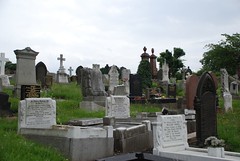
Last year my daughter showed me a website that she had to use for compiling tables to accompany some course-work. It was a list of the people who were buried in the General Cemetery in Sheffield, which opened in 1836. It made very sad reading and some of the causes of death mentioned were not familiar ones today. Babies were recorded as dieing from “teething” – one assumes it was an infection of some sort causing similar symptoms to the temperature and upset tummy that a baby has when it is cutting teeth.
The first burial recorded in the cemetery in 1836 was that of Mary Ann Fish, the 24 year old wife of a Book-keeper, and she died from Consumption. A few weeks later another Mary Ann arrived to keep her company, also having died from Consumption.
One poor little mite only lived a month, dieing from St Anthony’s Fire (erisypelas) – this is basically a strep. infection on the skin, causing necrolizing fascilitis and death from septic shock. Other babies died of smallpox, whooping cough, measles and croup and a good many from convulsions. One 4 year old infant died from “worm fever”, and another from “bilious fever” which could have been almost anything, and a w year old had a neck tumour. One aged four died of dropsy, and a 5 mth old baby died from “English Cholera”. They could die from “decline” at any age and a 7 year old died from “apoplexy” – something one would normally associate with a gouty old gentleman with high blood pressure . . . One poor little mite, only 3 mths old, died from Thrush, which obviously affected its ability to feed. Merchant’s daughter Mary Matilda Jemima Lamb Long died aged only 8, of bowel inflammation. Sadly her name was nearly longer than her life . . . An outbreak of influenza in February 1837 claimed many lives, and poor little Ferdinand Binney, aged 9 months, left Paradise Square in Sheffield for Paradise of a more final kind.
Some deaths were from infection – “debility from wound in thigh”, “consumption after ulcerated leg”, “decline from a wound in the foot” and water was often cited – “water in the head”, “water on the chest”, and “decline” or “natural decay” claimed a few.
Women died of childbirth, putrid fever, dropsy, stomach cramp (probably cancer), rheumatic fever, consumption – from just being born into the wrong time and place.
Death in the workhouse was frequent, and Typhus, Smallpox, Measles, and Scarlet Fever were regular visitors. Sometimes children were infected by two things together – Whooping Cough and Smallpox for example, or Scarlet Fever and Smallpox. Measles was often followed by a lung infection, which took the little one off. In the first two weeks of June 1838, the Workhouse was a centre of pestilence, with nine infants dieing from Scarlet Fever and Smallpox, and a 45 year old widow, “on the parish”, dieing from Consumption. I think I recall my daughter saying that the workhouse dead were either buried in a communal grave, or else popped in with whoever else had an open grave at that time.
A rough rule of thumb seems to have been the more wealthy you were, the better the Doctor’s analysis of cause of death. Whoever wrote “Visitation of God” as the cause of death must have been totally in the dark. A “Gentlemen” died from Ischuria renalis (renal failure I believe), and a spinster died from “Uterine cancer”, an iron founder’s widow died from “scirrhous stomach” (cancer), the wife of a Britannia Plate manufacturer – “sudden death – palpitations” which we may assume was a heart attack.
Details were given of the individual’s occupation, or that of the parents and they came from all walks of life – hosier, soldier, brewer, brass caster, table knife hafter, file smith, tailor, solicitor, frame smith, stove grate fitter, gardener ,farmer, shoemaker, joiner’s tool manufacturer, spring knife grinder, butcher, pawnbroker, whitesmith, excise officer, razor smith – all were there. “Infant” was the biggest occupation of all - and the most vulnerable . . .


3 comments:
Hello, I discovered your blog while researching Clootie Wells. How marvelous it (your blog) is. I havent read all the words but have skimmed a few posts and will return. I have in my heart some affinity for Wales. No idea why. The pickled pears sound yummy as does a "car boot sale." Oh my. Be well, suki
I think this must be the Cemetery on Cemetery Road that I drive past on my way into the city, I've never actually been in there but it's well-known for being full of interesting tombstones. The19th century burial registers of nearly all big city burial grounds make sad reading, we complain about the NHS but at least there is medical help available to all of us these days. I do know Paradise Square, it's one of the few remaining places in the city centre that still has its original old buildings and is still a proper square. Almost all the old buildings in the city were lost to either German bombing or 1960s clearances.
Hi Rowan - I must ask Tam to seek out Paradise Square with me next time I'm up there. It is a somewhat morbid thing to post about, but says a lot about the social history of the time - the real people.
Sukipoet - hi and welcome. I'm glad you enjoyed what you found here. I witter on about allsorts! Haste ye back.
Post a Comment